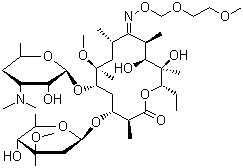Home > Offer to Sell > Intermediates > Pharmaceutical intermediates > Roxithromycin CAS 80214-83-1 (jerryzhang001@chembj.com)
Roxithromycin CAS 80214-83-1 (jerryzhang001@chembj.com)
Inquiry
| Post Date: | Apr 20,2017 |
| Expiry Date: | Apr 20,2018 |
| Detailed Description: |
Cas No. :80214-83-1
Payment Method: T/T; Western Union; Moneygram and Bitcoin Roxithromycin CAS 80214-83-1 Product Name: Roxithromycin; Synonyms: ROXITHROMYCIN;ERYTHROMYCIN 9-(-O-[2-METHOXYETHOXY]METHYLOXIME);ERYTHROMYCIN, 9-[O-[(2-METHOXYETHOXY)METHYL]OXIME], (9E)-;Roxithromycin CP2000;Roxithromycin EP;RoxithromycinEp/Bp/CpC41H76N2O15;RoxithromycinC41H76N2O15;(9E)-9-[O-[(2-Methoxyethoxy)methyl]oxime] Erythromycin; CAS: 80214-83-1; MF: C41H76N2O15; MW: 837.05; Product Categories: Antibiotic Explorer;Intermediates & Fine Chemicals;Pharmaceuticals;veterinary medicine,soluble powder;Peptide Synthesis/Antibiotics;Chiral Reagents; Melting point: 111-118°C; storage temp.: 2-8°C; Description: Roxithromycin is a semi-synthetic 14-membered ring macrolide antibiotic. It has similar mechanism of action as erythromycin with its antibacterial effect in vivo being 1-4 times stronger than erythromycin. Its effect against Gram-positive bacteria is slightly worse than erythromycin; the effect against Legionella pneumophila is somehow stronger than erythromycin; for Chlamydia pneumoniae, Mycoplasma pneumoniae and Ureaplasma urealyticum, it has similar or slightly stronger antimicrobial effect compared with erythromycin. Usage: 1. It belongs to macrolide antibiotics, being a kind of erythromycin derivative with the antibacterial spectrum being similar as erythromycin but having a 6 times stronger effect on erythromycin with high bioavailability. It is used for the treatment of respiratory tract infection, such as pneumonia, acute bronchitis, acute infection of chronic bronchitis, atypical pneumonia, and genitourinary system infection, skin and soft tissue infections, having good therapeutic effect and tolerance with smaller adverse reactions than erythromycin. 2. As the new generation of macrolide antibiotics; 3. The product belongs to a new generation of macrolide antibiotics, mainly used for Gram-positive bacteria, anaerobes, chlamydia and mycoplasma. Its antibacterial activity in vitro is similar as erythromycin with its in vivo effect being 1-4 times stronger than erythromycin. Pharmacological effects and indications 1, it has strong bactericidal effect on Gram-negative bacteria and some Gram-negative bacteria (meningococcus, Neisseria gonorrhoeae, influenza bacilli, pertussis, Brucella) and spirochetes, Mycoplasma pneumoniae and Rickettsia. Legionella is sensitive to it; its effect against mycoplasma and chlamydia is further enhanced. 4. 2, antibacterial mechanism: it can bind to the bacterial ribosome 50S subunit, through blocking the peptidyl transfer and MRNA displacement, further inhibiting the protein synthesis. 3, this product has excellent oral absorption and quick efficacy with stronger bioavailability and plasma concentrations than erythromycin. According to reports, oral administration of 150 mg can lead to a peak plasma concentration of up to 6.6 ~ 7.9 ug / ml while the value for erythromycin under the same conditions is only 0.2 ~ 0.4ug / ml; roxithromycin is mainly distributed in body fluids and tissues, with high and durable tissue concentration and cell concentration. Moreover, it has a half-life of up to 12 h while the value for erythromycin is only 1.5 ~ 2.0h. 4, in clinical medicine, it is the first-choice drug for the treatment of drug-resistance Staphylococcus aureus and hemolytic streptococcus. 5.In veterinary clinical practice, it is used for the treatment of penicillin-resistant staphylococcus aureus caused severe infection, pneumonia, uterine inflammation and poultry chronic respiratory disease. 5, the goods are mainly used for the treatment of livestock and poultry chronic respiratory disease with good efficacy in the treatment of livestock and poultry staphylococcus and streptococcal disease, chlamydia, spirocheal disease (swine dysentery), infectious pleurisy and rhinitis. 6, indications: avian neck swelling, local heat, pain, difficulty breathing, mouth and nose flow white foam, mucous membranes and skin cyanosis and other symptoms. |
| CAS Registry Number: | 80214-83-1 |
| Synonyms: | ;Roxythromycin;5-(3,4,6-trideoxy-3-dimethylamino-beta-d-xylo-hexopyranosyloxy)-3-(2,6-dideoxy-3-c-methyl-3-o-methyl-alpha-l-ribo-hexopyranosyloxy)-6,11,12-trihydroxy-9-(2-methoxyethoxy)methoxyimino-2,4,6,8,10,12-hexamethylpentadecan-13-olide;(3R,4S,5S,6R,7R,9R,11S,12R,13S,14R)-6-{[(2S,3R,4S,6R)-4-(dimethylamino)-3-hydroxy-6-methyltetrahydro-2H-pyran-2-yl]oxy}-14-ethyl-7,12,13-trihydroxy-4-{[(2R,4R,5S,6S)-5-hydroxy-4-methoxy-4,6-dimethyltetrahydro-2H-pyran-2-yl]oxy}-10-{[(2-methoxyethoxy)methoxy]imino}-3,5,7,9,11,13-hexamethyloxacyclotetradecan-2-one (non-preferred name);Roxithromycine; |
| Molecular Formula: | C41H76N2O15 |
| Molecular Weight: | 837.0465 |
| Molecular Structure: | 
|
| Hazard Symbols: |  Xn:Harmful; Xn:Harmful; |
| Risk Codes: | R22:; |
| Company: | Nanjing Bangnuo Biotechnology Co., Ltd. [ China ] |
| Contact: | Jerry Zhang |
| Tel: | 86-25-52198306 |
| Fax: | |
| Email: | jerryzhang001@chembj.com |
-
Disclaimer statement:The information and data included above have been realized by the enterprises and compiled by the staff, and are subject to change without notice to you. The Chemnet makes no warranties or representations whatsoever regarding the facticity, accuracy and validity of such information and data. In order to ensure your interest, we suggest you chose the products posted by our gold suppliers or VIP members.


